Explore Bulawayo - Zimbabwe Travel, Africa
Strategically located in the southwestern part of the country, Bulawayo, or the “City of Kings,” serves as a gateway to some of Zimbabwe's most treasured sites, including the Matobo National Park and Khami Ruins, both are UNESCO World Heritage Sites. Known for its rich history and cultural significance, Bulawayo invites travelers to explore its storied past and vibrant present. With its easy accessibility and an array of attractions, Bulawayo is a must-visit for those wanting to immerse themselves in Zimbabwean culture.
Population: Approximately 660,000 in 2022.
Economy: Bulawayo's economy is diverse, with key sectors including manufacturing, trade, and agriculture. The city is known for its industrial base and vibrant small businesses, contributing to its economic growth.
Landmarks: Famous for the Matobo National Park, Khami Ruins, and Bulawayo Railway Museum.
Zimbabwe
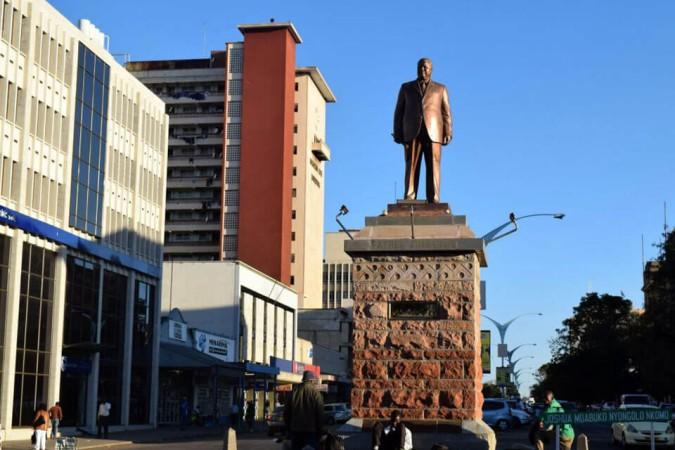
Overview of Bulawayo
History & Cultural Influence
Bulawayo boasts a fascinating history that dates back centuries, shaped by the Ndebele Kingdom, colonial influences, and Zimbabwe’s independence. Founded by King Lobengula in the 19th century, Bulawayo was once the capital of the Ndebele people, and its heritage remains an integral part of the city’s identity. Visitors can see this history come to life through the preserved colonial-era architecture and the industrial heritage of the city. Culturally, Bulawayo’s cultural identity is further celebrated in its lively art scene, with galleries showcasing works from local artisans and craftsmen. The city's streets are filled with sculptures, paintings, and murals that reflect its creative spirit and cultural pride.
Interaction with The Locals
Bulawayo is Zimbabwe's second-largest city, with the majority of the population belonging to the Ndebele ethnic group, though the city is also home to a mix of other ethnicities and cultures. Citizens of Bulawayo are known for their warm hospitality, strong community ties, and rich cultural heritage. English, Ndebele, and Shona are commonly spoken languages, reflecting the city's diversity. The people of Bulawayo are proud of their history and traditions, with a strong emphasis on arts, crafts, and community festivals.
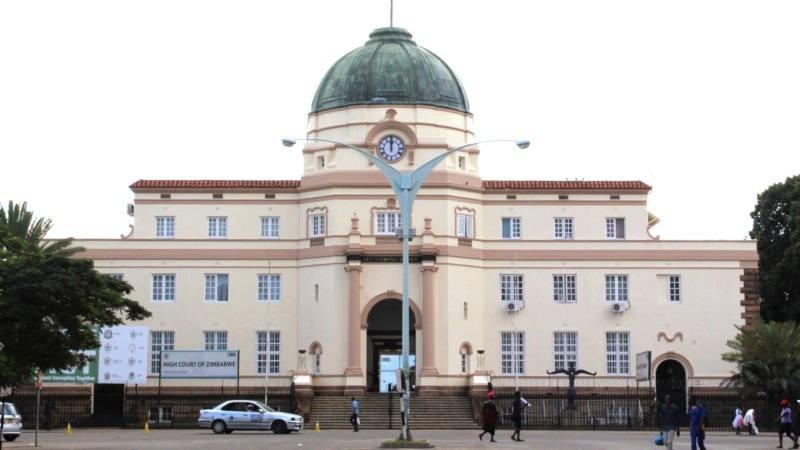
Bulawayo Town Hall - © Bulawayo Publicity Association
Top Attractions in Bulawayo
Bulawayo is home to some of Zimbabwe’s most captivating attractions, combining natural beauty, ancient history, and cultural landmarks. With a variety of must-visit sites, Bulawayo is a destination that promises adventure and discovery at every turn.
- Matobo National Park: Known for its stunning granite hills and balancing rocks, Matobo is a UNESCO World Heritage Site. It also has important rock art made by the San people over thousands of years. Visitors can enjoy hiking, wildlife viewing, and guided tours to see historical sites such as Cecil Rhodes’ grave.
- Khami Ruins: Just outside Bulawayo, this ancient city was once the capital of the Kingdom of Butua and is now a UNESCO World Heritage Site. Explore the stone walls, terraces, and towers that date back to the 15th century, offering a glimpse into Zimbabwe’s ancient civilizations.
- Bulawayo Railway Museum: A must for history enthusiasts, this museum showcases the city’s colonial past through an impressive collection of steam engines and railway memorabilia. Learn about Bulawayo's important position in southern Africa's transportation network.
- National Art Gallery: Located in the heart of Bulawayo, the gallery features contemporary Zimbabwean art, including works from both established and emerging artists. This is a great spot to appreciate local talent and purchase unique pieces.
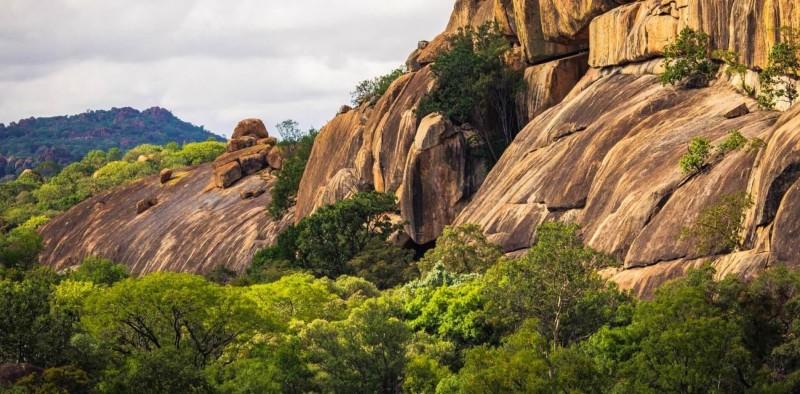
Matobo National Park - © Mzala Tom
Must-Try Dishes in Bulawayo
From hearty meat dishes to adventurous local snacks, Bulawayo's culinary tradition offers a delicious exploration of Zimbabwean traditions. Whether you're trying Sadza with game meat or sampling some Nyama, there's something for every palate.
- Sadza: A quintessential Zimbabwean staple, sadza is a thick porridge made from maize meal. It’s served with a variety of accompaniments such as beef stew, muriwo (leafy vegetables), or nyama. In Bulawayo, you can experience variations like Sadza Madora (served with mopane worms) or Sadza Mazondo (cow heels).
- Nyama (Grilled Meat): Known for its flavorful meat dishes, Bulawayo is home to a variety of grilled or stewed meats, commonly referred to as nyama. The local braai (barbecue) culture is strong, where you can savor grilled beef, goat meat, or chicken seasoned with Zimbabwean spices. Street vendors and markets are great places to find fresh, smoky nyama.
- Ulusu: Also known as tripe, this dish features the stomach lining of cows or goats, slow-cooked and often served with sadza. It is a popular traditional dish in Bulawayo, loved for its rich flavor and unique texture.
- Umxhanxa: A sweet and simple traditional dessert, Umxhanxa is made from boiled pumpkin and maize, sweetened to taste. This wholesome treat is a favorite among locals, especially during the harvest season.
- Bota: A breakfast porridge made from sorghum or maize meal, bota is often served with a side of peanut butter or honey for added flavor. It’s a warm, comforting start to the day, widely enjoyed across Zimbabwe, including Bulawayo.
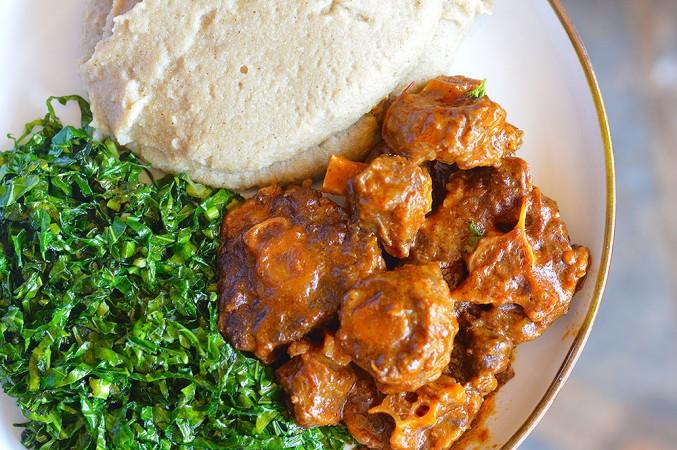
Sadza - © ZimboKitchen
Festivals & Local Celebrations
Bulawayo’s festivals and local celebrations offer an incredible window into the city’s vibrant culture, arts, and traditions. These celebrations offer travelers a chance to immerse themselves in local customs and creative expressions, making any visit to Bulawayo a truly enriching journey.
Intwasa Arts Festival
Held annually in September, the Intwasa Arts Festival is one of Zimbabwe’s largest and most important cultural events. This multi-disciplinary arts festival showcases the talents of local and international artists in various forms, including theater, dance, music, poetry, and visual arts. It offers visitors an opportunity to experience the creative heartbeat of Bulawayo, with performances and workshops held at different venues across the city. The festival promotes artistic expression and cultural exchange, while celebrating Bulawayo’s role as a cultural hub in Zimbabwe.
Umthwentwe (Traditional Ndebele Ceremony)
Umthwentwe is an annual celebration that honors the Ndebele culture and heritage. This ceremony typically involves traditional dances, songs, and rituals that are passed down through generations. Locals dress in vibrant traditional attire, and visitors are welcome to participate in the festivities. The event not only preserves the cultural identity of the Ndebele people but also fosters a sense of community and unity. It’s a fantastic opportunity for tourists to witness authentic Ndebele customs, as well as to engage with the local population in a meaningful way.
Makokoba Heritage Festival
Celebrating one of Bulawayo’s oldest neighborhoods, the Makokoba Heritage Festival is a community-driven event that highlights the cultural heritage and history of Makokoba Township. The festival includes street parades, storytelling, music, and art displays that reflect the neighborhood’s vibrant spirit. Visitors can experience local traditions up close and interact with the community through workshops and exhibitions. It’s a celebration of Bulawayo’s roots and the resilience of its people.
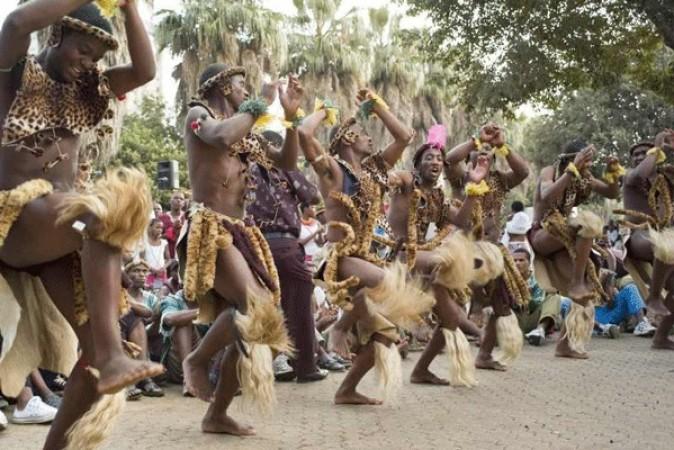
Umthwentwe (Traditional Ndebele Ceremony) - © AVAC Arts
What to Do in Bulawayo
- Wildlife Safari Tours: Take a day trip to Matobo National Park for game drives, where you can spot white rhinos, giraffes, leopards, and over 300 bird species. It’s an ideal destination for nature enthusiasts, offering walking safaris and scenic hikes among the park’s famous granite hills.
- Visit Cultural Village: Gain a deeper understanding of Zimbabwean rural life by visiting traditional Ndebele villages near Bulawayo. These tours allow you to learn about the customs, daily routines, and rich heritage of the local people.
- Historical Tours: Explore Khami Ruins and learn about Zimbabwe’s pre-colonial history with guided tours that explain the significance of this UNESCO World Heritage Site. The impressive stone structures and breathtaking views make it a highlight of any Bulawayo itinerary.
- Art and Museum Tours: Take a leisurely tour of Bulawayo’s National Art Gallery and Natural History Museum, where you can dive deep into the city’s cultural and scientific heritage. Both locations offer curated exhibits that showcase the best of Zimbabwean art and natural history.
Shopping in Bulawayo
Shopping in Bulawayo is not only an opportunity to take home unique Zimbabwean items, but it’s also a way to engage with the local culture and support the vibrant artisan community.
- Bulawayo City Market: For an authentic shopping experience, visit the bustling Bulawayo City Market, where you can buy traditional Zimbabwean crafts like pottery, woven baskets, beadwork, and fabrics. This market is a great place to find locally made items while supporting artisans and small businesses.
- Elephant’s Walk Village: This artisan hub features shops selling fine crafts, art, and jewelry made by Zimbabwean artists. Whether you're after unique sculptures or hand-painted textiles, Elephant’s Walk is a must-stop for quality souvenirs.
- Mhlahlandlela Shopping Centre: For those looking for a more modern shopping experience, Mhlahlandlela Centre offers a mix of local boutiques and retail shops. You can find fashion, electronics, and a range of other goods while exploring the city's urban shopping district.
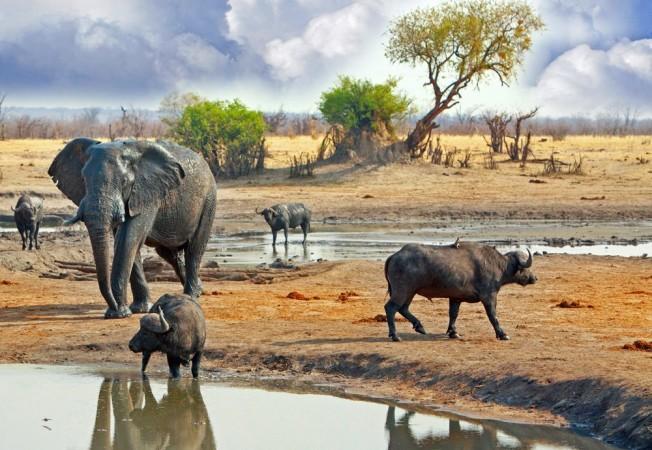
Wildlife Safari Tours in Matobo National Park - © Masai Mara Migration Safaris
Weather in Bulawayo: Best Time to Visit
Bulawayo has a subtropical highland climate marked by warm, dry winters and pleasant, rainy summers. Understanding Bulawayo’s weather helps ensure a pleasant and well-planned visit, allowing you to enjoy everything the city has to offer in comfort.
Wet Season in Bulawayo
Summers in Bulawayo are generally warm and wet. Temperatures range from 20°C to 30°C (68°F to 86°F), with occasional heavy rains that provide relief from the heat. This is an excellent time to see the lush landscapes and colorful foliage caused by the rainfall. However, be prepared for brief thunderstorms and occasional humidity.
Dry Season in Bulawayo
Winters are mild and dry, with temperatures ranging from 10°C to 25°C (50°F to 77°F). Nights can be quite cool, so packing warm layers is advisable. The dry season offers clear skies and pleasant weather, ideal for outdoor activities and sightseeing. This is the peak tourist season due to the comfortable temperatures and low humidity.
Best Time to Visit
The best time to visit Bulawayo is during the dry season months (April to October) when the weather is cooler and more comfortable for exploring outdoor attractions. The wet season months offer a different experience with lush landscapes but come with higher humidity and occasional rains.
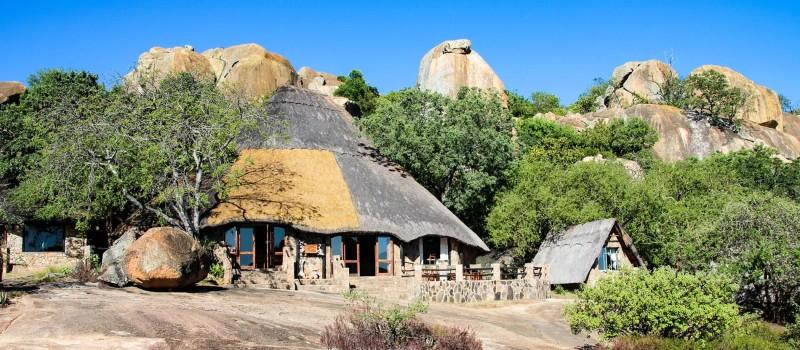
Enjoy eco-lodging in Matobo National Park - © Facts.net
Essential Travel Information
Getting Around Bulawayo
- Taxis and Ride-Sharing: Taxis are widely available throughout the city. It’s advisable to use reputable taxi services or ride-sharing apps like Uber for safety and convenience.
- Public Buses: Bulawayo has a network of public buses that connect different parts of the city and surrounding areas. Although economical, buses can be crowded and may not always adhere to strict schedules.
- Private Car Rentals: Renting a car offers flexibility and convenience, particularly for exploring attractions outside the city. Several rental agencies operate in Bulawayo, providing a range of vehicles for self-drive exploration.
- Bicycle Rentals: For a more leisurely way to explore the city, consider renting a bicycle. It’s a great way to see Bulawayo at a relaxed pace and navigate through the city’s parks and local neighborhoods.
- Walking: Many of Bulawayo’s key attractions are within walking distance of each other, especially in the city center. Walking is a wonderful way to explore your surroundings and engage with the local people.
ATM & Banking Services
With reliable banking and ATM services in Zimbabwe, you can easily handle your financial needs while exploring Bulawayo. ATMs are commonly found at major shopping centers, hotels, and public areas, accepting international cards for cash withdrawals. It’s advisable to inform your bank about your travel plans to ensure smooth transactions. Although the Zimbabwean Dollar is the native currency, US dollars are frequently accepted in many places. Currency exchange services are accessible in a variety of venues, including airports, banks, and exchange offices.
Where to Stay in Bulawayo
- Luxury Hotels: For a high-end experience, opt for luxury hotels that provide modern amenities such as comfortable rooms, fine dining, and exceptional service. These establishments offer a premium stay with a focus on comfort and elegance.
- Mid-Range Hotels: If you’re looking for a balance between comfort and cost, mid-range hotels offer essential amenities at a reasonable price. These hotels typically include services such as Wi-Fi, on-site dining, and convenient locations.
- Budget Lodgings: Budget travelers will find guesthouses and hostels that offer affordable rates while still providing essential comforts. These options are great for those seeking a cost-effective stay without sacrificing basic amenities.
- Unique Stays: For a distinctive experience, consider locally owned lodges or eco-friendly retreats. These options often offer a more immersive experience and the opportunity to engage with local communities.
Des articles pour vous

Voyage à Kampong Cham - Cambodge, Asie
Kampong Cham est une charmante ville riveraine située le long du fleuve Mékong. Connue pour son importance historique et ses attractions culturelles, Kampong Cham offre un mélange d'architecture coloniale, de temples anciens et de paysages pittoresques. Kampong Cham est reliée au district voisin de Tbong Khmum par le pont Kizuna, le premier pont au Cambodge à traverser le fleuve Mékong, en faisant un carrefour de transport crucial pour la région.
Population : Estimation de 80 000 habitants (en 2024)
Économie : Bien que n'étant pas encore une destination touristique majeure, Kampong Cham propose des sites culturels et historiques, tels que le temple Wat Nokor et le pont en bambou de Koh Pen, ainsi que des attractions naturelles comme des forêts et des chutes d'eau. Le gouvernement se concentre sur le développement du tourisme pour améliorer l'économie locale.
Points d'intérêt : Wat Nokor Bachey, Phnom Han Chey, Phnom Pros et Phnom Srey, pont en bambou de Koh Pen, Wat Joy T'maw, Preah Theat Teuk Chha, piste d'atterrissage abandonnée de l'US.

Explorez Nha Trang - Voyage au centre du Vietnam, Asie
Nichée le long de la magnifique côte du Vietnam, Nha Trang se distingue comme une destination de premier choix pour les voyageurs. Cette ville côtière, réputée pour ses superbes plages et sa vie marine foisonnante, s'adresse à tous. Nha Trang vous accueille à bras ouverts, que vous recherchiez des aventures, de la culture ou de la détente au bord de la mer. Ce guide vous fera découvrir les points forts de cet endroit magnifique, facilitant ainsi la planification de votre voyage de manière fluide et excitante.
Population : Environ 423 000 habitants en 2019.
Économie : L'un des principaux centres touristiques du Vietnam et la plus grande économie de la province de Khanh Hoa.
Sites emblématiques : Célèbre pour les tours Cham de Po Nagar, la cathédrale de Nha Trang et l'île Hon Mun.

Voyage à Sihanoukville - Cambodge, Asie
Sihanoukville, une ville côtière du sud-ouest du Cambodge, est la capitale de la province de Preah Sihanouk. Située sur une péninsule le long du golfe de Thaïlande, la ville est bien reliée à Phnom Penh par des autoroutes principales et dispose d'un aéroport international.
La ville abrite le seul port en eau profonde du Cambodge, jouant un rôle crucial dans la logistique et le commerce du pays. Les plages magnifiques de Sihanoukville, telles qu'Ochheuteal et Serendipity, attirent aussi bien les touristes nationaux qu'internationaux. Le développement économique a prospéré ces dernières années, en particulier grâce à la création de la Zone économique spéciale de Sihanoukville (SSEZ) et aux investissements chinois dans les casinos, l'immobilier et les stations balnéaires. La ville offre également des attractions naturelles telles que le parc national de Ream et plusieurs îles voisines, en faisant une destination variée pour les voyageurs d'affaires et de loisirs.
Population : La population de Sihanoukville était d'environ 160 000 habitants en 2024.
Économie : Sihanoukville, une ville côtière en pleine croissance au Cambodge, se distingue par son mélange dynamique de développement économique et de tourisme. La Zone économique spéciale de Sihanoukville (SSEZ) est devenue un pôle industriel majeur, abritant plus de 180 entreprises et créant des milliers d'emplois. Avec le seul port en eau profonde du Cambodge, la ville joue un rôle clé dans le commerce et la logistique du pays. Bien qu'elle se soit transformée d'une petite ville balnéaire tranquille en un centre urbain animé, Sihanoukville reste célèbre pour ses plages immaculées, attirant des touristes tout au long de l'année. Les investissements chinois importants ont alimenté la croissance des hôtels, des casinos et de l'immobilier, faisant de la ville un centre d'opportunités économiques et d'hospitalité.
Monuments : Plage d'Otres, Plage d'Ochheuteal, Plage de l'Indépendance, Parc national de Ream, Chute d'eau de Kbal Chhay, Monument des Lions d'Or, Wat Leu.

Explorez Kharkhorin - Voyage en Mongolie, Asie
Bienvenue à Kharkhorin, un trésor historique niché au cœur de la Mongolie. Ancienne capitale vibrante de l'Empire Mongol sous le légendaire Gengis Khan, Kharkhorin se dresse comme un témoignage de la riche culture et de l'histoire de la Mongolie. Cette ville antique possède une combinaison unique d'importance historique et de paysages époustouflants, en faisant une destination incontournable pour un voyage de rêve en Mongolie. En mettant le pied à Kharkhorin, vous ferez un saut dans le temps, à une époque de grands palais, de routes commerciales prospères et d'échanges culturels sans pareils. Que vous soyez intrigué par les ruines anciennes, désireux d'explorer les traditions locales ou simplement en quête d'une immersion dans la beauté naturelle de la Mongolie, Kharkhorin a quelque chose à offrir à chacun.
Population : Environ 1 000 habitants en 2020.
Économie : L'une des attractions touristiques les plus importantes de la Mongolie et l'ancienne capitale de l'Empire Mongol.
Monuments : Célèbre pour les Ruines de Kharkhorin, le Monastère d'Erdene Zuu, et la Vallée d'Orkhon, un site du patrimoine mondial de l'UNESCO.

Explore Luang Prabang - Laos Travel, Asia
Luang Prabang, nestled in northern Laos at the meeting point of the Mekong river and Nam Khan river, is a city celebrated for its rich cultural heritage and stunning natural beauty. Recognized as a UNESCO World Heritage Site in 1995, it boasts a unique blend of traditional Lao and French architecture that has been carefully preserved. Whether you're wandering through its ancient temples, admiring the local architecture, or soaking in the natural beauty of waterfalls and rivers, Luang Prabang offers something for everyone.
Population: Approximately 470,000 in 2020.
Economy: Luang Prabang's economy thrives on tourism, with its UNESCO status drawing visitors to its temples, natural wonders, and cultural experiences. Local crafts, hospitality, and small businesses also play vital roles, supporting the town's sustainable growth. Local crafts, hospitality, and small businesses also play vital roles, supporting the town's sustainable growth.
Landmarks: Famous for the Wat Xieng Thong, Royal Palace Museum (also known as Haw Kham), and Mount Phousi (Phou Si Hill).Luang Prabang, nestled in northern Laos at the meeting point of the Mekong river and Nam Khan river, is a city celebrated for its rich cultural heritage and stunning natural beauty. Recognized as a UNESCO World Heritage Site in 1995, it boasts a unique blend of traditional Lao and French architecture that has been carefully preserved. Whether you're wandering through its ancient temples, admiring the local architecture, or soaking in the natural beauty of waterfalls and rivers, Luang Prabang offers something for everyone.
Population: Approximately 470,000 in 2020.
Economy: Luang Prabang's economy thrives on tourism, with its UNESCO status drawing visitors to its temples, natural wonders, and cultural experiences. Local crafts, hospitality, and small businesses also play vital roles, supporting the town's sustainable growth. Local crafts, hospitality, and small businesses also play vital roles, supporting the town's sustainable growth.
Landmarks: Famous for the Wat Xieng Thong, Royal Palace Museum (also known as Haw Kham), and Mount Phousi (Phou Si Hill).

Explore Vientiane - Laos Travel, Asia
Vientiane, the capital of Laos, offers a unique travel experience for those looking to explore a peaceful Southeast Asian city with a deep connection to its cultural roots. Unlike other bustling capitals, Vientiane boasts a serene and laid-back atmosphere, making it a perfect destination for travelers wanting to escape the chaos of more crowded cities. This charming city sits along the Mekong River, offering scenic views, rich history, and a vibrant yet tranquil way of life. As a gateway to exploring Laos, this capital invites you to slow down, immerse in its heritage, and enjoy the local flavors.
Population: Approximately 840,000 in 2023.
Economy: Vientiane's economy is growing steadily, driven by government services, trade, and tourism. Key sectors include agriculture, manufacturing, and construction. The city's strategic location along the Mekong River supports trade with neighboring Thailand and Vietnam.
Landmarks: Famous for the Pha That Luang, Patuxai, and the Buddha Park (or Wat Xieng Khuan).
